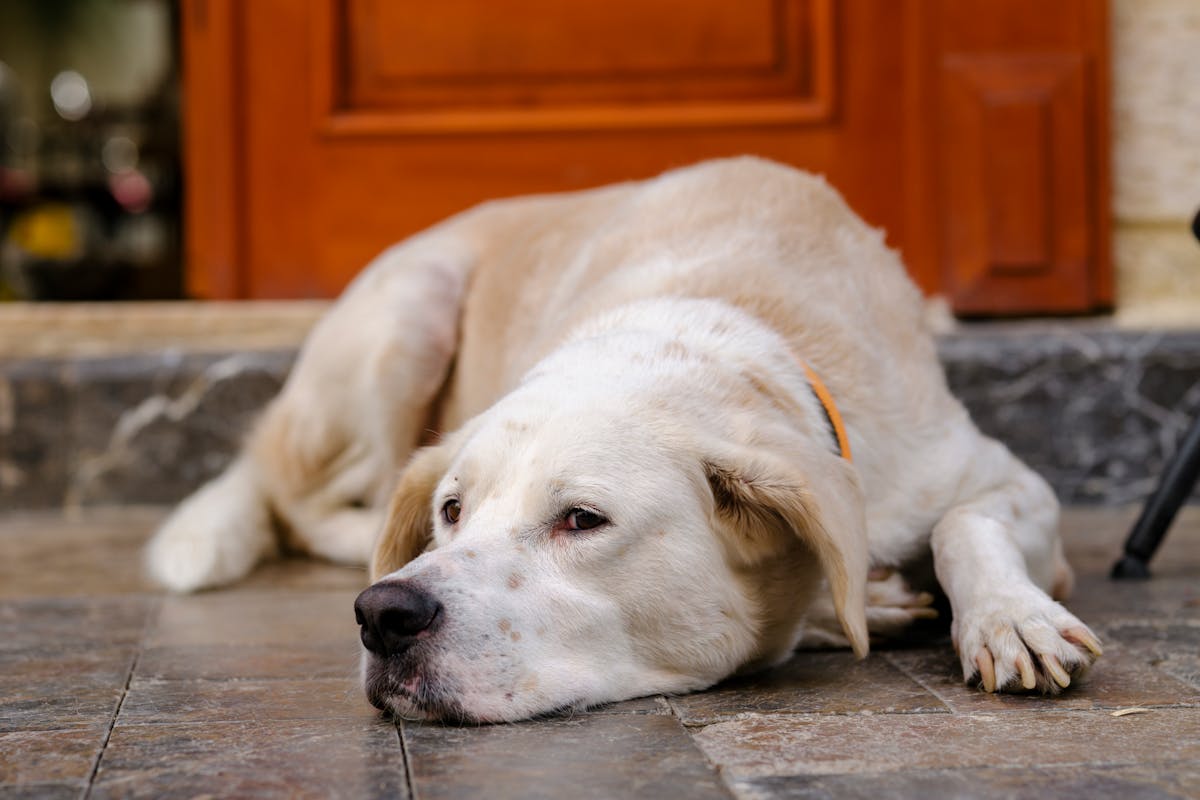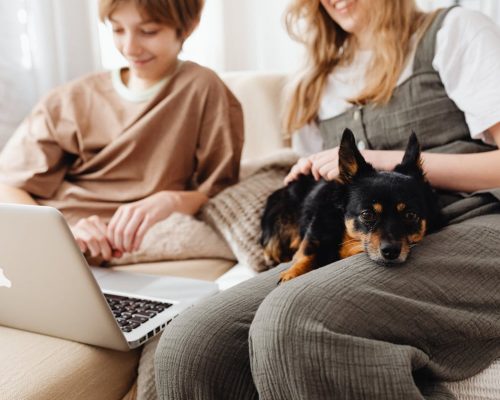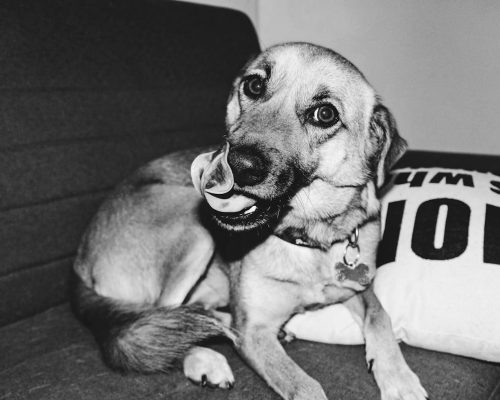Dog Anxiety is a multifaceted condition that manifests in various forms. Just like humans, dogs experience anxiety due to a range of triggers, including separation from their owners, loud noises, or changes in their environment.
Dog anxiety is not simply a fleeting moment of discomfort—it can develop into a chronic condition if not managed effectively.
Table of Contents
ToggleThe Complex Nature of Canine Anxiety
Canine anxiety is often rooted in both environmental and genetic factors. Dogs may exhibit anxious behaviours like barking, pacing, trembling, or destructive tendencies when their stress levels peak. These behaviours may worsen if the underlying causes remain unaddressed.
Common Causes of Anxiety in Dogs
Common triggers of dog anxiety include separation, loud noises such as thunderstorms or fireworks, and unfamiliar social settings.
Dogs with past trauma, like rescue dogs, may also carry long-term stressors that affect their behaviour. Identifying the root cause is essential for addressing anxiety effectively.
Why Exercise is Key to Managing Dog Anxiety
Exercise plays a crucial role in managing and reducing anxiety in dogs. A well-exercised dog is more likely to be calm, focused, and less prone to anxious outbursts. It provides a constructive outlet for excess energy and tension that could otherwise exacerbate anxiety symptoms.
Physical Activity as a Natural Calming Agent
Exercise triggers the release of endorphins, which are natural mood enhancers. These hormones help reduce stress levels and promote a sense of calm. By engaging a dog’s mind and body, physical activity serves as an organic remedy for their anxiety.
The Science Behind Exercise and Anxiety Reduction
Scientific studies support the idea that regular exercise can significantly decrease anxiety levels in dogs. Physical activity helps regulate cortisol—the hormone responsible for stress—while increasing serotonin and dopamine, both of which contribute to an overall sense of well-being.
Tip 1: Daily Walks for Consistency and Routine
One of the simplest yet most effective ways to manage dog anxiety is by establishing a routine through daily walks. Regular walks provide dogs with a structured activity that they can rely on. This predictability helps reduce anxiety by creating a stable and familiar environment for the dog.
Establishing Predictability Through Regular Walks
Dogs thrive on routine. A consistent daily walk helps reduce uncertainty, which is often a cause of anxiety. Knowing what to expect each day, in terms of physical activity and engagement, provides anxious dogs with much-needed security.
The Power of Exploration and Socialization on Walks
Walks also offer dogs the opportunity to explore their environment, interact with other animals, and take in new scents and sounds. This mental stimulation is crucial for their cognitive health and helps distract them from stress-inducing thoughts or situations.
Tip 2: Interactive Play to Channel Energy
Interactive playtime is another essential exercise strategy for dogs suffering from anxiety. Games like fetch, tug-of-war, or using puzzle toys not only engage dogs physically but also stimulate their minds, providing a productive outlet for their nervous energy.
Benefits of Fetch, Tug-of-War, and Puzzle Toys
Interactive games give dogs a sense of accomplishment and purpose. For instance, fetch channels their natural instincts while providing a structured and rewarding experience. Puzzle toys, on the other hand, challenge their mental abilities, helping reduce stress through problem-solving.
How Play Stimulates Both Mind and Body
Engaging in play encourages physical exertion while keeping the dog’s mind occupied. This dual engagement allows dogs to release pent-up energy and avoid destructive behaviours born out of boredom or anxiety.
Tip 3: Agility Training for Focus and Confidence
Agility training is not just for competitive dogs—it’s an excellent way to focus an anxious dog’s energy while building their confidence. By setting up simple obstacle courses, you can engage your dog in physical and mental tasks that keep them occupied and less anxious.
Building Trust and Reducing Nervous Energy
Agility exercises require dogs to focus on commands and follow through with specific actions. This directed activity builds trust between the dog and their owner while diverting nervous energy into positive, purposeful action.
Simple Agility Exercises You Can Do at Home
You don’t need professional equipment for agility training. Simple activities like weaving through cones, jumping over small hurdles, or running through tunnels can be done with everyday household items and still provide the same anxiety-reducing benefits.
Tip 4: Swimming for Low-Impact Anxiety Relief
Swimming is an excellent low-impact exercise for dogs, especially those with joint issues or high levels of anxiety. The resistance provided by water offers a calming sensation, while the activity itself helps burn off excess energy that could fuel anxiety.
Why Swimming Is an Excellent Choice for Anxious Dogs
The buoyancy of water reduces strain on the joints, making swimming an ideal exercise for older or more anxious dogs.
It also offers a relaxing environment, where the dog can focus on the sensations of moving through water rather than on their anxiety triggers.
How Water-Based Activities Help Soothe Tension
Water activities engage dogs in a soothing, rhythmic motion that can reduce their heart rate and promote relaxation. The repetitive nature of swimming provides a consistent and meditative-like experience for the dog, alleviating stress over time.
Tip 5: Structured Exercise to Foster Calmness
Structured exercises, such as obedience training combined with physical activity, provide a dual benefit. They help the dog associate calmness with physical exertion, using commands to instil discipline and calmness even during high-energy activities.
Using Commands and Rewards to Promote Calm Behavior
Training your dog to follow commands while exercising can promote calm behaviour. By rewarding calm actions, such as sitting or waiting before chasing a ball, you instil a sense of control that reduces anxiety during periods of high excitement.
Techniques for Keeping Your Dog Mentally Engaged During Exercise
Keeping a dog mentally engaged during exercise can be as simple as varying the activities or introducing new challenges. This mental stimulation prevents boredom and creates a positive association between exercise and reduced anxiety.
Recognizing the Signs of Improvement in Your Dog
It’s important to note changes in your dog’s behaviour as you incorporate regular exercise into their routine. Gradually, you may notice that your dog is less reactive to anxiety triggers, displays a calmer demeanour, and shows fewer signs of stress.
Subtle Changes in Behavior After Regular Exercise
Look for subtle signs of improvement, such as your dog resting more peacefully after play or becoming more confident in social situations. These are indicators that, thanks to consistent exercise, their anxiety is beginning to subside.
How to Know If Your Dog’s Anxiety Is Lessening
Signs that your dog’s anxiety decreases include reduced pacing, less frequent destructive behaviours, and improved interaction with family members or other pets. Exercise can transform an anxious dog into a well-balanced companion over time.
Complementing Exercise with Other Calming Techniques
While exercise is a powerful tool for reducing dog anxiety, it’s most effective when combined with other calming strategies such as a balanced diet, supplements, or additional training methods designed to address specific anxiety triggers.
Combining Exercise with Diet, Supplements, and Training
Some dogs may benefit from calming supplements like CBD or a diet rich in omega-3 fatty acids. When paired with regular exercise, these strategies create a holistic approach that addresses both the physical and emotional aspects of anxiety.
The Role of a Holistic Approach in Reducing Anxiety
A holistic approach, which includes exercise, diet, and training, provides comprehensive support for dogs battling anxiety.
This multi-faceted strategy ensures that all aspects of their well-being are taken into account, leading to more sustainable results.
Conclusion: A Happier, Healthier Dog Through Exercise
Incorporating regular exercise into your dog’s routine is one of the most effective ways to beat anxiety. By following the five tips outlined above, you can help your dog live a more balanced and stress-free life.
From daily walks to structured training, the right exercises can greatly improve your dog’s mental and physical health. Consistency is key, and a little effort each day can lead to significant reductions in anxiety over time.
Exercise is not a cure-all, but it’s a powerful tool in the fight against dog anxiety. With dedication and a thoughtful approach, you can help your anxious dog feel more secure, calm, and content.






